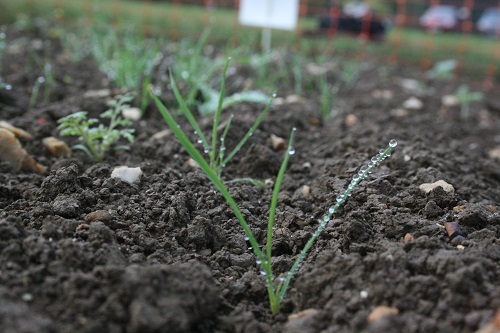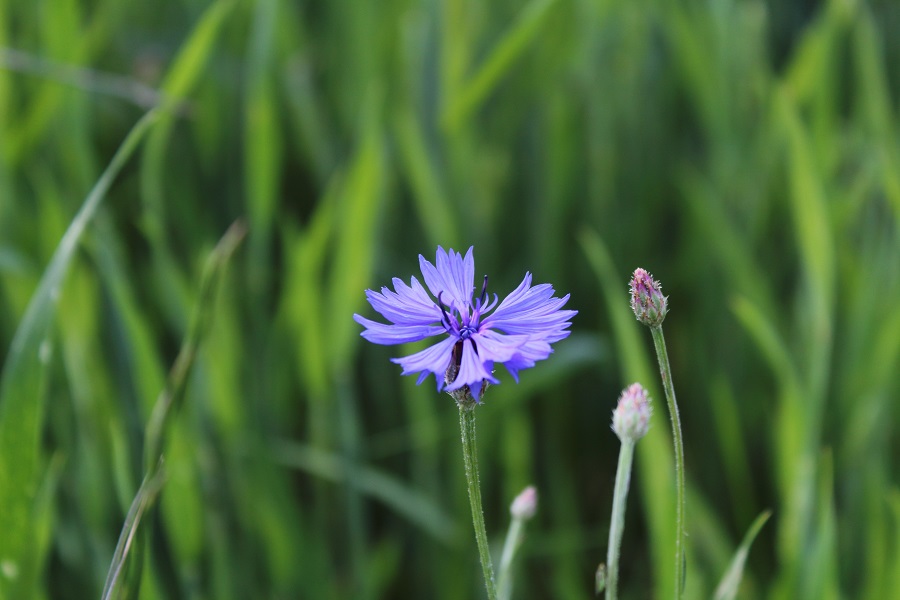You don’t have to be Einstein to know that doing the same thing and expecting a different result is the definition of insanity. Is it time to look at managing weeds in a different light? CPM reports.
Use little hammers and not sledgehammers.
By Lucy de la Pasture
Blackgrass has become a weed that’s driving farming strategies on many farms – its success and the failure of herbicide measures has led to changes in rotations, cultivations and herbicide use. But instead of a weed being the force behind changes in practice, could weeds be thought about in a different way and be managed more ecologically? That was the question posed by Dr Chloe MacLaren, plant ecologist at Rothamsted Research, during AHDB’s Agronomy Week.
Chloe points out that the way weeds are being managed across the globe is a struggle, with 262 weed species found to be resistant to 23 of the 26 herbicide modes of action (MoA) available in an international survey published last year.

Intensive use of herbicides selects for weeds with a similar growth habit, metabolism and resource requirement as the crop itself, hence the success of blackgrass as a weed.
“There’s a real risk that we may run out of chemistry to control some weeds. Resistance is expensive, with the annual cost of blackgrass resistance in England estimated at £0.4bn in lost gross profit (2014 prices) to the industry. According to research published in the scientific journal Nature Sustainability, in winter wheat the cost of herbicides can be anything between £75-450/ha for blackgrass control.
“The more we study the problem, the tricker it seems to be getting. We used to think that if you mixed herbicide MoAs then it would prevent resistance, then as time went on it was realised resistance was still evolving. Recent research from Rothamsted, led by David Comont, is showing that mixing herbicides does delay target site resistance, but at the same time it also promotes the development of cross-resistance,” she explains.
Chloe also points out that more intensive weed control can select for more problematic weeds. On a farming systems level, weeds which are generally tolerant or good at avoiding control are becoming increasingly common. “These weeds achieve this through strategies such as variable germination times or short growth periods, which means they can grow rapidly in the periods between times when effective controls can be applied.
“Intensive weed control can degrade farmland’s natural capital, with potential negative effects on both farm productivity and the environment,” believes Chloe.
Regular and intensive tillage is a major contributor to unsustainable levels of soil erosion, she adds. “In Europe, soil erosion rates are from 3-40 times more than the upper limit of tolerable soil erosion. Both tillage and herbicides have some effect on soil microbes, particularly mycorrhizae.
“We don’t know enough about this yet to know if that contributes to a change or loss in function of soil microbes, but it does suggest we want to be careful about how often we use either of these tools.”
The conventional approach to weed control is also a major cause of biodiversity loss in farmland – critically bird biodiversity depends on the variety of weed seeds that are available, she highlights.
“Several arable weeds are being farmed to extinction but we’re still losing the war on weeds. The more we study them, it seems that the weeds will always win. We need new ways of thinking about weeds,” she says. Foremost Chloe suggests it’s not necessary to get rid of all weeds and that instead the aim should be for farms to be more resilient to problematic weeds.
“We don’t want huge populations of species like blackgrass, but we do want to foster a diverse community of wild plants so that the weed benefits outweigh the costs of having them there,” she says. “Amongst the positive functions of weeds are soil protection, nutrient cycling and interaction with beneficial insects – providing pest interference and pollinator support. Removing weeds habitually means all these functions can potentially be lost.”
Long-term research studies show that many weed species may not be as competitive with the crop as most people think, she adds. “Weed diversity is associated with reduced competition between weeds and the crop. There is evidence for this in Rothamsted’s long-term Broadbalk experiment, where researchers compared plots with high weed diversity to plots with low weed diversity.
When plots with high diversity (~20 species) were left unsprayed, the yield loss caused by the weeds was much less than in plots with low diversity (5-6 species): 30% compared with 65-80%.
A further long-term study in France published in Nature Sustainability looked at the effect of different cropping systems and found different weed communities developed in each system over time in response to the management used. In unweeded and zero weeded plots the researchers found six distinct weed communities, four of which decreased yields (20-55%) but two had no effect on yields.
“The yield loss was also less as weed diversity increased. The study found yield wasn’t strongly correlated to weed density but was highest in weed communities dominated by blackgrass and cleavers, and lowest where field pansy or speedwell were present with enhanced weed diversity.”
Chloe suggests that the question in agronomist’s and farmer’s minds shouldn’t be ‘how weedy is the field?’, but more ‘which weeds are there and how many different species are present?’ when making weed control decisions.
“Weeds which are beneficial in crops are small, slow-growing, mainly large-seeded flowering plants. These are less competitive with the crop while providing more services to biodiversity. Tall, fast-growing, competitive weeds – such as blackgrass and wild oats – aren’t desirable,” she explains.
Putting the theory into practice is tricky, and solutions will be specific to farming systems and sites, admits Chloe. But there are a number of things to avoid, she says.
“Firstly, try to avoid consistently penalising weeds for being different to the crop. Examples of this are always eliminating weeds that germinate before the crop, disadvantaging weeds that use alternative resources or are more stress tolerant or using in-crop herbicides that eliminate weeds that have different metabolisms of growth forms. This results in selecting for weeds that are similar to the crop and benefit from the same resources, so are more competitive in nature.
“Secondly, avoid doing the same thing each year as this exacerbates the problem of selection for similar and more competitive weeds. Then, if possible, try not to create an environment where the only worry the weed has is resisting control.
In intensive systems with short-strawed cereals, high fertilisation rates and pesticide use, this means that weeds face little competition and few enemies or pathogens – meaning the only selection pressure is herbicides.”
To manage weeds in a more ecologically sound way there are four main principles, says Chloe. “Increase diversity in all its forms, use little hammers and not sledgehammers, minimise resource availability and take advantage of the positive effects of weeds. All of these are useful for pest-pathogen management and nutrient-use efficiency,” she explains.
“Increasing diversity in all its forms refers to increasing crop and management diversity – in rotations and in different fields – to avoid creating a consistent environment where well-adapted weeds can proliferate.
“Increasing other forms of biodiversity – whether farmed (such as livestock) or wild (such as seed-predating insects) – can also help to suppress weeds. The use of ‘little hammers rather than sledgehammers’ encourage tactics that target just a few species at specific times and places, while allowing beneficial species to persist.”
Chloe gives the example of using little hammers in practice. These are techniques such as intercrops and cover crops, rather than sprayed or tilled inter-rows or fallows; using mowing or weed wipers to target tall competitive weeds, while leaving short species untouched; using reduced tillage frequencies and precision application of herbicides.
“Minimising resource ability means limiting light, nutrients and water to weeds. Not only do more free resources mean more weeds, but high resource availability helps fast-growing problematic weeds in particular.
“This can be avoided by choosing competitive crops, using precision techniques such as variable rate fertiliser applications and drip irrigation, and/or choosing organic nutrient sources (legumes and manures) that release nutrients more slowly. Light to weeds can also be limited by shading the soil with intercrops, crop residues and mulches,” she explains.
If those three principles are followed, Chloe is optimistic that the last principle, ‘take advantage of the positive aspects of weeds’, will come naturally. “Increasing diversity, avoiding sledgehammers and reducing resource ability should lead us toward farming systems that are resilient to problematic weeds whilst allowing a diversity of less competitive wild plants to persist. These remaining ‘weeds’ (in this case perhaps better termed ‘wild companion plants’) will then contribute to soil quality and supporting beneficial biodiversity,” she comments.
Agronomist Steve Cook of Hampshire Arable Systems says that enhancing biodiversity probably comes low on the list of priorities for most agronomists, whose main aims are to avoid yield losses and optimise grower margins.
But he also says that weed problems have built up in recent years. “Agronomists are having to use some pretty big sledgehammers and pushing things too hard, but they’ve had to tackle blackgrass.”
He puts part of the problem down to poorer rotations which have reduced crop biodiversity but has also observed that farmers seem to have a reduced tolerance of weeds in their crops than perhaps they did several years ago.
Steve believes that there are good reasons behind the desire for clean crops, including ease and speed of harvest and that even though in theory it should be possible to leave behind the less competitive weeds, in practice herbicide actives are mostly broad spectrum, even in spring.
But more and more growers are finding that where there’s a will, there’s a way and David Miller of Wheatsheaf Farming Company in Hampshire is one of these. He’s adapted his farming system to improve soil health and reduce dependency on inputs on his 700ha of Grade 3 ground.
“Herbicides were developed after World War 2 with the intention of being used in conjunction with cultural controls. Weed control has now become a reactive system which relies on applying herbicides.”
David moved to no-till six years ago and uses cover crops extensively to bridge the gap between cash crops on the farm. In this time he’s already seeing a significant reduction in blackgrass and a shift in the weed species present, with less-competitive weeds becoming more prevalent.
Companion crops also feature heavily in his system. This autumn, oilseed rape was drilled with a mixture of vetch, berseem and crimson clover and buckwheat and established successfully without the use of any herbicides or insecticides. After a good frost has thinned out some of the more susceptible companion plants, David removes the rest using Astrokerb (propyzamide+ aminopyralid).
All the spring-cropped land on the farm benefits from a mixed-species cover of sunflowers, vetch, lupins, camelina, berseem and crimson clover and buckwheat over the winter. ““There’s a natural sequence of senescence in the mix and we use a Cambridge roll when conditions are frosty in Jan to bruise the remaining crop, enhancing die-back,” he says.
Nitrogen use is one of the factors David is looking very closely at in his farming system. “The last tonne of yield can require 100kgN/ha and when you consider the negative side of nitrogen application, what it does to the soil and weeds, then you have to question whether the extra yield is worth it.”




